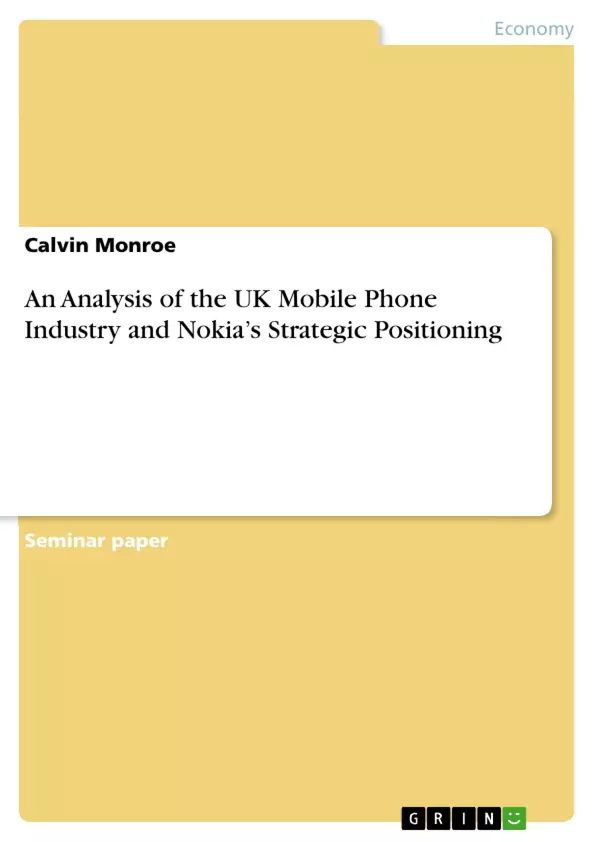The micro environment can be defined as that which consists of the groups that the company deals with on a regular basis. The microenvironment is thus comprised of the suppliers to the firm, the customers, distributors and other companies in the industry with which the firm competes with. In analysing these groups scholars have come up with a model that is specifically targeted at this kind of analysis which is called Porter’s five forces analysis (Lamb, Hair, & McDaniel, 2011). According Porter, the model presents five forces that determine the competitive nature of the microenvironment within which a firm operates in. scholars argue that a highly unattractive industry will be one that all the five forces found in the model are strongly present and this would mean that there is perfect competition. The model consists of the following forces: threat of new entrants, bargaining power of suppliers, threat of substitutes and the rivalry among existing competitors (Kurtz, 2008).
Inhaltsverzeichnis (Table of Contents)
- An Analysis of the UK Mobile Phone Industry and Nokia's Strategic Positioning
- Micro-environmental analysis
- Threat of New entrants
- Power of suppliers
- Buyer power
- Degree of rivalry
- Threat of substitutes
- Strategic positioning at Nokia
Zielsetzung und Themenschwerpunkte (Objectives and Key Themes)
This analysis aims to examine the UK mobile phone industry's microenvironment and assess Nokia's strategic positioning within it. The study uses Porter's Five Forces framework to analyze the competitive landscape and explores how Nokia leverages its internal strengths to achieve a strong market position.
- Analysis of the UK mobile phone industry's competitive dynamics using Porter's Five Forces.
- Assessment of the power of suppliers and buyers in the industry.
- Examination of the threat of new entrants and substitute products.
- Evaluation of Nokia's strategic positioning based on market and resource-based approaches.
- Discussion of the factors influencing Nokia's success and its ability to adapt to market changes.
Zusammenfassung der Kapitel (Chapter Summaries)
Micro-environmental analysis: This chapter analyzes the UK mobile phone industry's microenvironment using Porter's Five Forces framework. It examines the threat of new entrants, considering both the high capital investment required and the increased opportunities for software-focused companies. The power of suppliers is discussed, noting the generally mediocre market power but acknowledging instances of supplier dominance. Buyer power is analyzed, considering different buyer categories (consumers, retailers, service providers, and businesses) and brand loyalty. The chapter also explores the intense rivalry among existing competitors, highlighting the diverse market segments and the constant struggle for market share. Finally, the threat of substitutes is deemed low due to the mobile phone's integration of various functionalities.
Strategic positioning at Nokia: This chapter focuses on Nokia's strategic positioning within the market. It defines strategic positioning and emphasizes the importance of aligning the organization's strategy with its external environment, internal capabilities, and stakeholder expectations. The PESTEL framework is utilized to analyze Nokia's external environment, demonstrating a supportive political, economic, social, and legal climate in the UK. Nokia's strategic choice is presented as a combination of market-oriented and resource-based approaches, highlighting its ability to identify market opportunities and leverage its technological strengths. The chapter concludes by emphasizing the importance of aligning strategy with strategic position to achieve long-term success, a key aspect that Nokia successfully achieved.
Schlüsselwörter (Keywords)
UK mobile phone industry, Nokia, strategic positioning, Porter's Five Forces, microenvironment, competitive analysis, market analysis, supplier power, buyer power, rivalry, substitutes, PESTEL analysis, market-oriented strategy, resource-based view.
Analysis of the UK Mobile Phone Industry and Nokia's Strategic Positioning: Frequently Asked Questions
What is the purpose of this analysis?
This analysis examines the UK mobile phone industry's microenvironment and assesses Nokia's strategic positioning within it. It uses Porter's Five Forces framework and explores how Nokia uses its strengths to achieve a strong market position.
What key themes are covered in this analysis?
Key themes include analyzing the UK mobile phone industry's competitive dynamics using Porter's Five Forces, assessing supplier and buyer power, examining threats from new entrants and substitute products, evaluating Nokia's strategic positioning, and discussing factors influencing Nokia's success and adaptability.
What is the micro-environmental analysis based on?
The micro-environmental analysis utilizes Porter's Five Forces framework to examine the threat of new entrants (considering high capital investment and opportunities for software-focused companies), supplier power (noting generally mediocre power but acknowledging instances of dominance), buyer power (considering consumer, retailer, service provider, and business categories and brand loyalty), intense rivalry among existing competitors, and the threat of substitutes (deemed low due to the mobile phone's integrated functionalities).
How is Nokia's strategic positioning analyzed?
Nokia's strategic positioning is analyzed by defining strategic positioning and emphasizing the alignment of organizational strategy with external environment, internal capabilities, and stakeholder expectations. The PESTEL framework is used to analyze Nokia's external environment. The analysis highlights Nokia's strategic choices as a combination of market-oriented and resource-based approaches, emphasizing its ability to identify market opportunities and leverage technological strengths. The importance of aligning strategy with strategic position for long-term success is emphasized.
What are the key takeaways regarding Nokia's success?
Nokia's success is attributed to its ability to identify market opportunities, leverage its technological strengths, and effectively align its strategy with its strategic position, demonstrating adaptability to market changes and a successful combination of market-oriented and resource-based approaches.
What keywords describe this analysis?
Key words include UK mobile phone industry, Nokia, strategic positioning, Porter's Five Forces, microenvironment, competitive analysis, market analysis, supplier power, buyer power, rivalry, substitutes, PESTEL analysis, market-oriented strategy, and resource-based view.
What frameworks are used in this analysis?
This analysis utilizes Porter's Five Forces framework for competitive analysis and the PESTEL framework for analyzing Nokia's external environment. It also incorporates market-oriented and resource-based strategic approaches.
- Quote paper
- Calvin Monroe (Author), 2012, An Analysis of the UK Mobile Phone Industry and Nokia’s Strategic Positioning, Munich, GRIN Verlag, https://www.grin.com/document/269414



